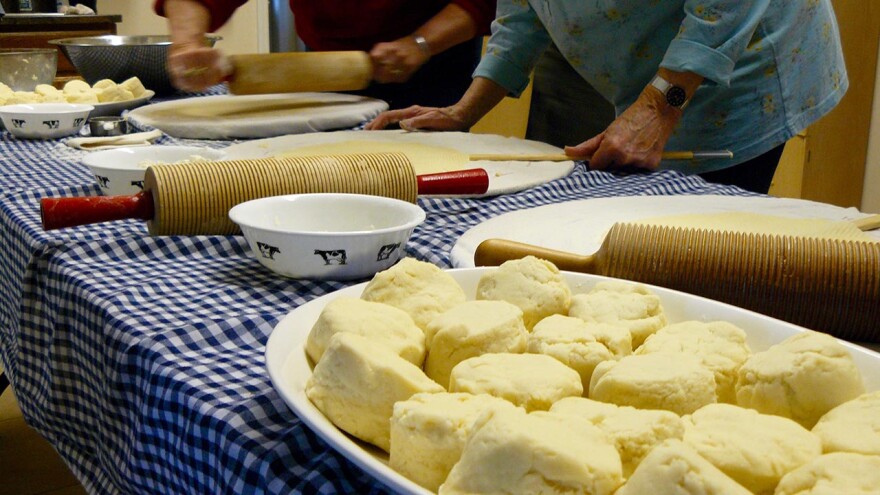Food can be a powerful connection to the people and places of our past, and help define who we are today. We may not dress like our ancestors or speak the same language, but some food traditions remain strong, especially around the holidays. But why is this?
Perhaps the answer lies in the fact that preparing and consuming food is a multi-sensory experience. It engages all five of our senses, which means that we are more likely to form stronger memories and associate particular foods with people, holidays and events. The experience becomes both a physical and a symbolic act.
On a Sunday afternoon in December, Marietta Pfister and a dozen others gather at Our Savior’s Lutheran Church in Bonner, Montana, to make krumkake (pronounced krum-caca) cookies and Lefse, a soft Norwegian flatbread. The Nordic heritage foods will be donated as part of the church’s 'Ministry of Care' outreach to people from the congregation who are ill or unable to attend services.

Marietta spoons batter into her mother’s "Made in Norway" krumkake iron. The two-sided iron cooks the batter and imprints it with swirling designs inspired by a decorative Nordic painting style called rosemaling. Once golden brown, she removes the cookie with a fork, and her assistant uses a special cone roller to shape it, allowing it to cool and harden into a crisp wafer.
Like other Nordic sweet treats, krumkake is essentially edible folk art. Even though most Nordic cookie recipes call for the same basic ingredients (i.e., flour, sugar, eggs and butter), each is distinguished by its structure and delicate details. From airy, flower-shaped rosettes to knotted and crimped fattigman, the designs create aesthetic diversity while affecting how they are consumed.
Eating cone-shaped krumkake is much messier than goro, a soft, rectangular-shaped cookie imprinted with a floral design. But Marietta doesn’t seem to mind a few krumkake crumbs. She grew up making the cone-shaped cookies with her family, and the recipe she uses today is marked by her mother’s handwriting – little notes that suggest almond extract and what kind of roller to use. She and her husband, Bob, have been teaching their granddaughters how to make krumkake, and every year, they gather to make about 60 of the cookies for Christmas Eve.
"Sometimes it’s hard not to eat them beforehand, and we have to make a second batch," says Marietta.
She scoops up another spoonful of batter, and pauses before pouring it into the iron.
"Making krumkake reminds me of my grandparents," she says.
Most of the volunteers in the church kitchen are Norwegian American. Between 1865 and 1930, approximately 780,000 Norwegians immigrated to the United States. Rapid population growth, limited agricultural lands, mechanization on farms, and few industrialized jobs led to the mass exodus from Norway.
Second to the Irish, this was the largest immigrant group of its time. By 1910, 80 percent of the Norwegian immigrants and their children had settled in the Upper Midwest, but some made it out to western Montana. They brought their Lutheran ethic and Nordic food traditions with them.
By observing the production lines in the church kitchen, it’s clear that some of these food traditions are best with a group of family or friends. To make the lefse, two people measure out the dough – a combination of mashed potatoes, flour, butter, and cream – as three volunteers roll it flat with grooved rolling pins. It’s as thin as a tortilla, but lefse is much softer than other types of flatbread and can tear easily. This is because the potato-based dough lacks the high levels of gluten (i.e., the strong, stretchy protein network that forms when flour and water are mixed together) found in flour-based breads.
The volunteers carefully slide long, flat paddles called lefse sticks underneath the rolled-out dough to pick it up and transfer it to one of the four griddles. A guard watches over each lefse, carefully flipping it until it turns golden in color, as someone else folds the cooked lefse into fourths and sets it on a rack to cool.

In the coming weeks, Marietta and her husband Bob will be making more lefse in their home by the Blackfoot River.
"Bob is real good at rolling [the lefse], and I can flip pretty good," says Marietta. "We make a good team."
Bob grew up in a Norwegian-German household and always helped his family make lefse for Christmas. Many of the lefse sticks being used in the kitchen today are family heirlooms. Some have brightly painted handles, but Bob’s lefse stick is relatively plain. What makes it special are the signatures from his parents and mother-in-law, children and grandchildren. Three generations have used this stick to continue an important family tradition.
"Normally we make lefse for Thanksgiving, too," says Bob. "We forgot this year, and the girls were upset."
Bob picks up one of the lefse considered too homely for the Ministry of Care packages, and spreads it with butter and brown sugar. He rolls it up and cuts it into bite-sized samples for all the volunteers. Marietta prefers white sugar, and they joke about whose cooking method is better for krumkake.
"I have a timer sitting there that I watch when I’m doing it – 20 seconds in the krumkake iron," says Bob.
Marrietta says her husband and son are more mathematically minded. They use a timer, but she prefers to go with her gut. After a lifetime of making krumkake, she knows when it’s ready.

